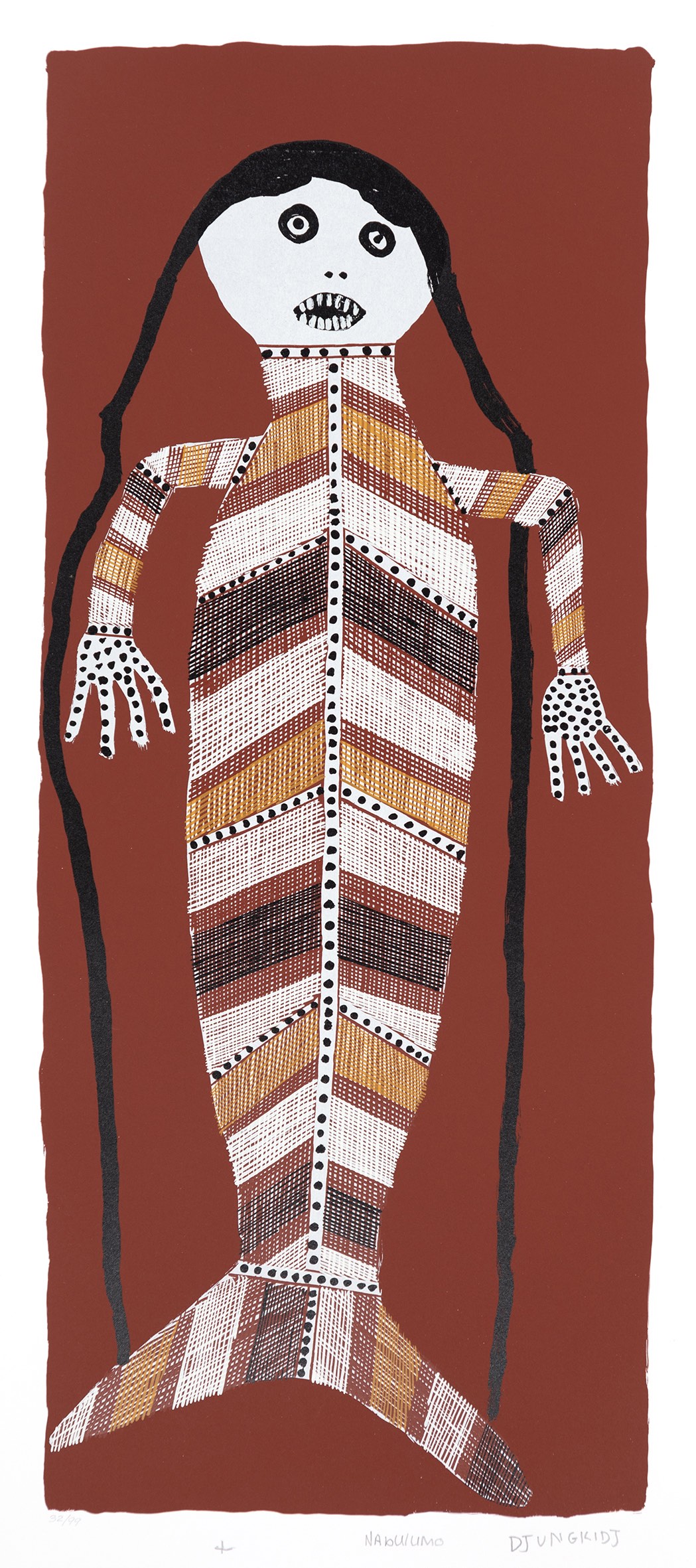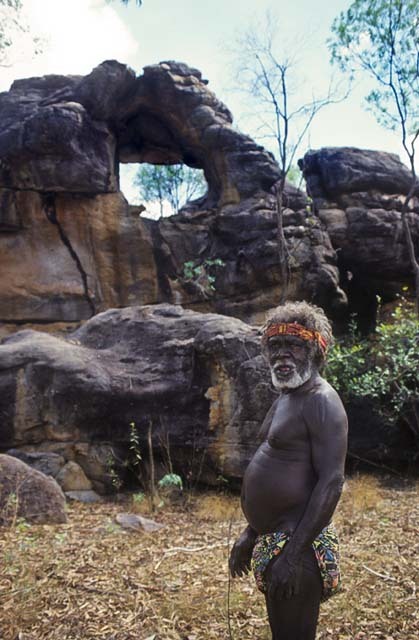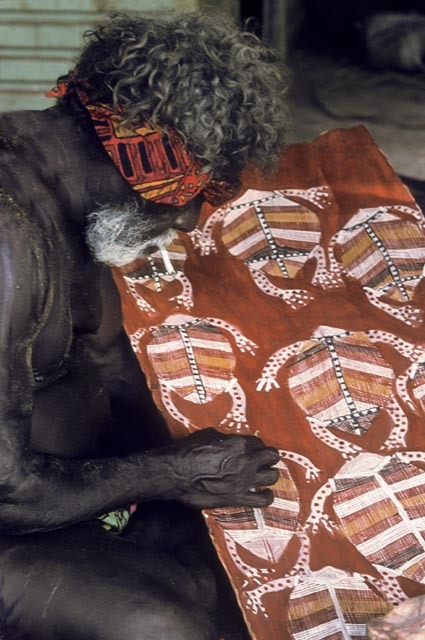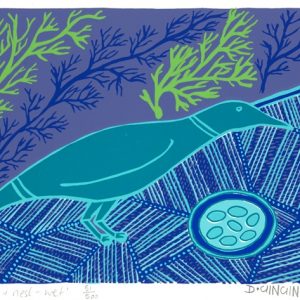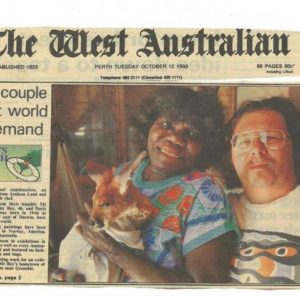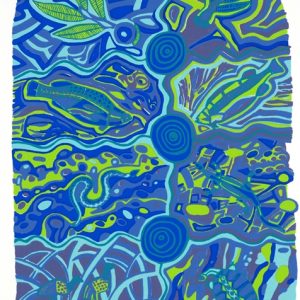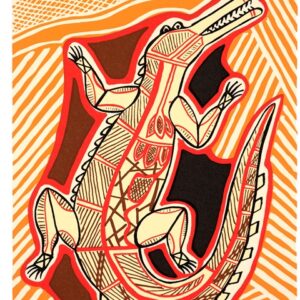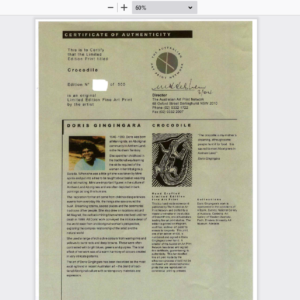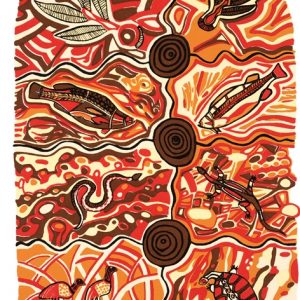Description
About the artwork:
Yawk Yawk are female water spirits that closely resemble the European concept of mermaids. Half spirit, half fish, they may entice unwary fishermen beneath the water of the lagoons that are their domain throughout Arnhem Land. They may have long hair like trailing water weeds and can take on the features of fish or the body of a water snake. When fully grown Yawk Yawk can leave their water holes to forage for food by changing their fishtails into legs to walk on dry land or assume the shape of a dragonfly to fly. Baby Yawk Yawk can take the form of dragonfly larvae. Yawk Yawk figures are also closely associated with Ngalyod, the Rainbow Serpent creation ancestor, and can be associated with sorcery.
Yawk Yawk is the Kunwinjku/Kuninjku word for young women.
Details
- Limited edition screenprint on paper
- Edition: 99
- Editioned: August, 1999
- Size: 800 x 330 mm (image), 1000 x 515 mm (paper)
- Paper: Magnani 350 gms
- Printer & Studio: Helen Berry, Northern Editions Darwin, NT, March 2000
About the artists: Mick Kubarkku
c1922-2008
Mick Kubarkku is recognised as being one of the great Kunwinjku/Kuninjku artists. He was born c.1922 at Kukabarnka, the large Marrinj clan wetland area near the Liverpool River of Western Arnhem Land. Having spent his youth largely oblivious to a European presence, he was one of the few who remembered the old men who painted the caves there, and could give detailed interpretations of their content. His father Ngindjalakku, instructed him in the creation of paintings for sacred ceremonies and he lived between his father’s Kulmarru land and his mother’s Kardbam country. As he matured through adolescence he attended and made art for the many Kunabibi, Wubarr and Mardayin ceremonies that were held there. It was not until the outbreak of the war that Kubarkku was rounded up with his brothers and sent to Milingimbi Mission. Kubarkku returned to his country at the end of the war, however, wanting tobacco, he decided to live at Oenpelli and work at the buffalo shooters camps.
Though he had sold a few barks at Oenpelli beforehand, Kubarkku moved to the new Government settlement of Maningrida in 1957 and along with David Milaybuma became the first of the regular painters there. A system of marketing art had operated since the 1950’s at Yirrkala and Millingimbi however it would be twelve years after Kubarkku began painting on bark before Maningrida Arts and Culture would be established in 1969.
In his early barks, Kubarkku restricted himself to the dotted infill reminiscent of rock paintings. However, later he incorporated his father’s ‘rarrk’ cross-hatching from the Mardayin ceremony into a rugged and individual painting style. Gowan Armstrong, Maningrida’s chaplain, recalled that ‘the ever cheerful Mick Gubargu (sic) began to bring his crocodile paintings from about 1970s onwards‘ (cited in Altman 2004: 176). These were accompanied by barks depicting other totemic animals including barramundi, turtle, kangaroo and echidna. The crosshatching that adorned these and other totemic figures at the time was not the meticulous geometric rarrk, common throughout Arnhem Land. It was less refined than that of many of his contemporaries, having a similarity in style to the rock markings found in the country near Kubumi, where he lived during the most artistically productive period of his life. His subject matter and stories were a direct continuation of that cave-art tradition executed with a raw, rough, and direct quality, in which the use of white dotted areas on black is a stylistic marker.
With thanks to Coo-ee Gallery, Sydney NSW. Full artist’s profile here.
Kubarkku’s artworks were included in a number of Australian and international exhibitions and accompanying publications catalogues from 1983 onwards. He was featured in the 1995 exhibition and catalogue: Rainbow, Sugarbag and Moon, Two Artists of the Stone Country: Bardayal Nadjamerrek and Mick Kubarkku, edited by Margie West and published by Museum and Art Gallery of the Northern Territory.
Provenance:
This edition was created in partnership with Maningrida Arts & Culture and commissioned by Anne Phelan and John Clark of Framed Gallery. Framed was the premier fine art and craft gallery in Darwin that operated from 1984-2017. The artist was paid his fee in full at the time of printing.
This artwork was distributed by the Australian Art Print Network.

